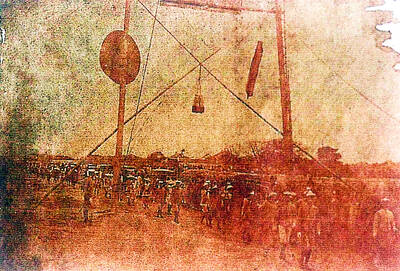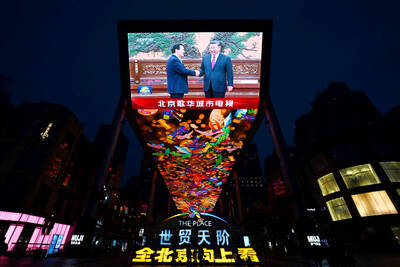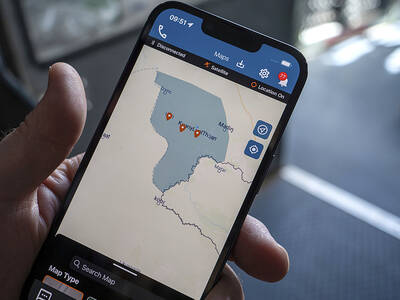US health officials closed down a spoof Starbucks coffee shop Monday shortly after a TV comic revealed himself as the man behind the stunt, which drew media attention and plenty of customers.
The “Dumb Starbucks” cropped up in a Los Angeles neighborhood on Friday adorned with the signature green logo and signage of the global coffee giant, except with the word “Dumb” sitting above it. Long lines formed outside the shop over the weekend as word of mouth and social media attracted large crowds, with some people reportedly waiting over an hour to be served.
Canadian comedian Nathan Fielder, known for a Comedy Central prank show, came forward yesterday and said it was his idea.

Photo: AFP
In a “press conference” outside the shop and a video posted on YouTube, he said: “By adding the word ‘dumb,’ we are legally allowed to use the coveted Starbucks name and logo because we’ve fulfilled the minimum requirements to be considered a parody under US law.”
“Many of you probably know me as a comedian, but this is no bit or joke,” he said. “This is a real business I plan to get rich from,” he deadpanned.
But a short time later the LA County Department of Public Health swooped and posted a “notice of closure” on the door, saying the business was “operating without a valid public health permit.”
Corporate giant Starbucks said before the shop was closed down: “It is not affiliated with Starbucks.
“We are evaluating our next step. While we appreciate the humor of the store, they cannot use our name. It is a protected trademark.” Fielder said he plans to open a second location in Brooklyn, New York.

June 23 to June 29 After capturing the walled city of Hsinchu on June 22, 1895, the Japanese hoped to quickly push south and seize control of Taiwan’s entire west coast — but their advance was stalled for more than a month. Not only did local Hakka fighters continue to cause them headaches, resistance forces even attempted to retake the city three times. “We had planned to occupy Anping (Tainan) and Takao (Kaohsiung) as soon as possible, but ever since we took Hsinchu, nearby bandits proclaiming to be ‘righteous people’ (義民) have been destroying train tracks and electrical cables, and gathering in villages

This year will go down in the history books. Taiwan faces enormous turmoil and uncertainty in the coming months. Which political parties are in a good position to handle big changes? All of the main parties are beset with challenges. Taking stock, this column examined the Taiwan People’s Party (TPP) (“Huang Kuo-chang’s choking the life out of the TPP,” May 28, page 12), the Democratic Progressive Party (DPP) (“Challenges amid choppy waters for the DPP,” June 14, page 12) and the Chinese Nationalist Party (KMT) (“KMT struggles to seize opportunities as ‘interesting times’ loom,” June 20, page 11). Times like these can

Dr. Y. Tony Yang, Associate Dean of Health Policy and Population Science at George Washington University, argued last week in a piece for the Taipei Times about former president Ma Ying-jeou (馬英九) leading a student delegation to the People’s Republic of China (PRC) that, “The real question is not whether Ma’s visit helps or hurts Taiwan — it is why Taiwan lacks a sophisticated, multi-track approach to one of the most complex geopolitical relationships in the world” (“Ma’s Visit, DPP’s Blind Spot,” June 18, page 8). Yang contends that the Democratic Progressive Party (DPP) has a blind spot: “By treating any

Swooping low over the banks of a Nile River tributary, an aid flight run by retired American military officers released a stream of food-stuffed sacks over a town emptied by fighting in South Sudan, a country wracked by conflict. Last week’s air drop was the latest in a controversial development — private contracting firms led by former US intelligence officers and military veterans delivering aid to some of the world’s deadliest conflict zones, in operations organized with governments that are combatants in the conflicts. The moves are roiling the global aid community, which warns of a more militarized, politicized and profit-seeking trend